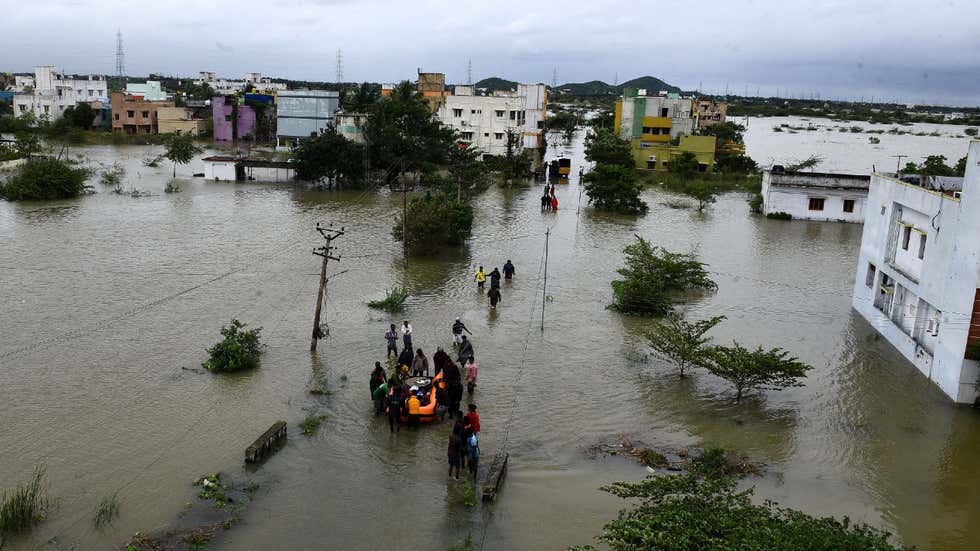
Fifteen extreme weather events, influenced by climate change, were identified globally this year, including the terrible floods that struck India cost $10 billion, killing 2,000, a UK charity report said on Monday.
The London-based Christian Aid's report, 'Counting the cost 2020: A year of climate breakdown', said 10 of those events cost $1.5 billion or more.
The US was hit by the highest costs due to the record-breaking hurricane season and fires. Most of these estimates are based only on insured losses, meaning the true financial costs are likely to be higher.
While the report focuses on financial costs, which are usually higher in richer countries because they have more valuable property, some extreme weather events in 2020 were devastating in poorer countries, even though the price tag was lower.
South Sudan, for example, experienced one of its worst floods on record, which killed 138 people and destroyed the year's crops. Some of the disasters hit fast, like cyclone Amphan, which struck the Bay of Bengal in May and caused losses valued at $13 billion in just a few days.
Other events unfolded over months, like floods in China and India, which had an estimated cost of $32 billion and $10 billion respectively.
Six of the 10 most costly events took place in Asia, five of them associated with an unusually rainy monsoon. And in Africa, huge locust swarms ravaged crops and vegetation across several countries, causing damages estimated at $8.5 billion.
The outbreak has been linked to wet conditions brought about by unusual rains fuelled by climate change. But the impact of extreme weather was felt all over the world. In Europe, two extra-tropical cyclones, Ciara and Alex, had a combined cost of almost $6 billion.
The US suffered from both a record-breaking hurricane season and a record-breaking fire season adding up to more than $60 billion in damages.
Some less populated places also suffered the consequences of a warming world. In Siberia, a heat wave during the first half of the year set a record in the city of Verkhoyansk, with temperatures reaching 38 degrees Celsius.
A few months later, on the other side of the world, heat and drought drove the fires in Bolivia, Argentina, Paraguay and Brazil.
While there were no human casualties reported from these events, the destruction of these areas has a great impact on biodiversity and the planet's capacity to respond to a warmer world.
While climate change may have influenced all these events, many of the countries that bear little responsibility for global warming were affected. This includes Nicaragua, which was hit by hurricane Iota, the strongest storm of the Atlantic hurricane season, and the Philippines, where typhoons Goni and Vamco made landfall almost back-to-back.
These extreme events highlight the need for urgent climate action.
The Paris Agreement, which set the goal of keeping temperature rise "well below" 2 degrees Celsius, and ideally 1.5 degrees, compared to pre-industrial levels, has just turned five years old. It is critical that countries commit to bold new targets ahead of the next climate conference, which will take place in Glasgow in November 2021.
The report's author Kat Kramer, Christian Aid's climate policy lead, told IANS: "The COVID-19 pandemic has understandably been a major worry this year. For millions of people in vulnerable parts of the world, climate breakdown has compounded this.
"The good news is that, like the vaccine for COVID-19, we do know how to fix the climate crisis. We need to keep fossil fuels in the ground, boost clean energy investment and help those who are suffering on the frontline.
"Whether it be floods in Asia, locusts in Africa or storms in Europe and the Americas, climate change has continued to rage in 2020. It is vital that 2021 ushers in a new era of activity to turn this tide.
"With US President-elect Biden in the White House, social movements across the world calling for urgent action, post-Covid green recovery investment and a crucial UN climate summit hosted by the UK, there is a major opportunity for countries to put us on a path to a safe future."
Roxy Mathew Koll, climate scientist at the Indian Institute of Tropical Meteorology in Pune, said: "2020 was exceptionally warm, as far as the Indian Ocean is concerned. We saw record temperatures in the Arabian Sea and Bay of Bengal, straddling between 30-33 degrees Celsius.
"These high temperatures had the characteristics of marine heatwaves that might have led to the rapid intensification of the pre-monsoon cyclones Amphan and Nisarga. Amphan was one of the strongest cyclones ever recorded in the Bay of Bengal during the pre-monsoon season."
M. Shahjahan Mondal, climate scientist and Director of the Institute of Flood and Water Management, Bangladesh University of Engineering and Technology, said: "Scientific evidence shows that the intensity of the tropical cyclones in the Bay of Bengal has been increasing over the past few years because of the temperature rise, and cyclone Amphan was one of the strongest ever recorded this year as a consequence.
"Moreover, the 2020 flood was one of the worst in history (of Bangladesh), as more than a quarter of the country was under water."
"Not only is this linked with changing climatic conditions and global warming, but also linked with changing land-use patterns and deforestation. Unfortunately, the situation might be worsening in the coming years if we fail to achieve the Paris climate goal to restrict global warming under 1.5 degrees Celsius."